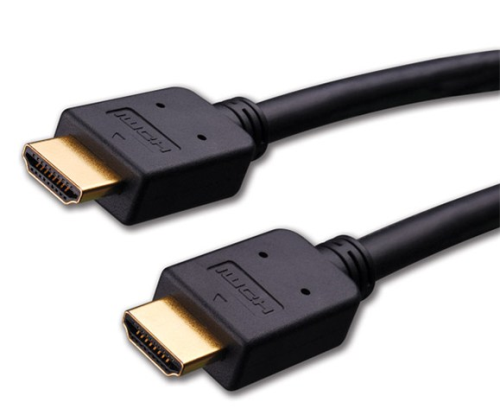At this point pretty much everyone recognizes the lowly HDMI cable. It’s the wire that goes from your cable or satellite box to your TV. The HDMI cable was created to please everyone from major movie studios to impatient spouses. For the most part it does a good job.

The problem we used to have
In the early days of HD, back in the 2000s, you had two choices for connections. Component connections took at least five cables to go from your box to your TV. If you had surround sound you were looking at nine cables. Yes really. This was not so popular with home theatre fans who wanted a clean installation. Their other option, the DVI connector, was really delicate and tended to break.
At the same time, the signals that travel over these old connections aren’t copy protected and that made the movie studios mad. They didn’t want you hooking up a video capture device and copying movies to your hard drive… because you might sell them for less than the studios could. Something had to be done.
The HDMI cable arrives
The HDMI Cable came into being in the mid-2000s to address all these problems. The one, easy to plug cable carries video and audio and uses a really fancy tap-dancing scheme to make sure that copy protected content is safe. It took a few years for everyone to figure out how to do it right, but HDMI is now the standard for all HD devices.
For a while, pretty much every HDMI cable on the market was largely identical in the way it performed. A couple years ago I started advocating that people toss all their old HDMI cables. The reason is simple. HDMI cables won’t tell you on the outside whether they will work with 4K or high dynamic range. A cable may work for you, or it may not. The worst part is that it may work for a little while and stop working unexpectedly. The best thing to do is simply buy better cables now and toss the old ones.
HDMI cables and computer monitors
There’s been another, quieter revolution that has involved HDMI. If you think about it, your computer probably has an HDMI connection on it now. A decade ago, in fact as little as five years ago, it might not have. Or it might have had the friendly VGA connector in addition to HDMI. Computer manufacturers have been slow to adopt HDMI because the truth is, it’s not a very good fit for computers.
Computer manufacturers don’t have an incentive to pay for copy-protection licenses, meaning that they didn’t need to migrate to HDMI as quickly. On the other side of the coin, they’ve also been slow to adopt the higher-speed HDMI standards that would give top quality when you’re using a 4K monitor.
Specialty HDMI cables
There is a whole category of HDMI cables that most folks don’t know about. Because HDMI has a built-in limitation of about 50 feet (due to copy protection issues) there’s a whole cottage industry in helping people extend HDMI beyond that. Some cables actually re-encode the signal within them, while others change it to a fiber optic connection. All the magic is done within the cable so you don’t even notice. You’ll notice the price, though, as long HDMI cables can get pricey.
Want to know more about HDMI cables?
Of course, you’ll find the best selection of HDMI cables at Solid Signal. And, if you need something special, you can call the experts! Call 888-233-7563 during East Coast business hours to find out more. If it’s after hours, fill out the form below. We’ll get back to you, usually within one business day.



